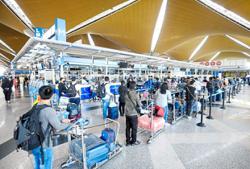At least 25 killed as powerful quake strikes Myanmar, sows panic in Bangkok and Hanoi
YANGON/BANGKOK/HANOI (Agencies): A powerful earthquake rocked Myanmar and neighbouring Thailand and Vietnam on March 28, killing at least 25 people, toppling buildings, bridges and an air traffic control tower, and rupturing roads.
The 7.7-magnitude tremor hit north-west of the city of Sagaing at a shallow depth, the United States Geological Survey (USGS) said. A 6.4-magnitude aftershock hit the same area minutes later.
In Bangkok, a 30-storey building under construction collapsed.
At least three people were killed and dozens of workers rescued from under the rubble of the skyscraper, Thai Deputy Prime Minister Phumtham Wechayachai said.
Rescuers were seeking to free 81 more people still trapped in the building’s ruins.
The massive building intended for government offices was reduced to a tangle of rubble and twisted metal in seconds, footage shared on social media showed.
“When I arrived to inspect the site, I heard people calling for help, saying ‘help me’,” Mr Worapat Sukthai, deputy police chief of Bang Sue district, said.
“We estimate that hundreds of people are injured, but we are still determining the number of casualties,” he said.
Across the border in Myanmar, at least 20 people were killed and 200 injured in Mandalay, the country’s ancient royal capital that is at the centre of its Buddhist heartland, according to Dr Kyaw Zin, of the Mandalay General Hospital.
Ms Daw Kyi Shwin, 45, said her three-year-old daughter was among those who died. They were having lunch in their house when the earthquake struck.
“As soon as it started, I ran downstairs, but I didn’t make it in time,” Ms Kyi Shwin said. “I tried to run to her, but before I could, bricks fell on me too.”
She was bleeding heavily as she spoke outside the hospital.
“There’s no government to help us, not enough doctors to care for us,” she said. “I’m going to die. I don’t want to die. Please help.”
The Yangon Times reported that the air traffic control tower at the airport in Naypyitaw collapsed, killing everyone inside.
Operations at Naypyitaw and Mandalay airports have been shut, the newspaper reported, citing a source with the ruling military junta.
Several ministry buildings, including those housing the Foreign Ministry and the Ministry of Labour, in Naypyitaw likewise collapsed, killing many, including the Permanent Secretary of the Ministry of Labour and some foreign officials, according to the Yangon Times.
Local media also reported that two people died after a hotel crumbled into rubble in Aung Ban town, in Shan state.
A team of journalists were at the National Museum in Naypyitaw when the earthquake struck.
Pieces fell from the ceiling as the building began shaking. Uniformed staff ran outside, some trembling and tearful, others grabbing cellphones to try to contact loved ones.
Roads nearby were buckled and broken by the tremors, and the route to one of the city’s biggest hospitals was jammed with traffic.
The hospital was a “mass casualty area” after the quake, officials said.
An ambulance made its way between vehicles, with a paramedic shouting “cars, move aside so the ambulance can get through”.
At the 1,000-bed hospital, the wounded were being treated in the street outside, intravenous drips hanging from their gurneys.
Some writhed in pain, while others lay still as relatives sought to comfort them.
Myanmar’s ruling junta made a rare request for international humanitarian aid and declared a state of emergency across six regions.
Reporters saw the junta chief, Senior General Min Aung Hlaing, arrive at a hospital in Naypyitaw where those wounded were being treated.
Panic far and wide
The tremors sent people into the streets across Myanmar and Thailand.
“I heard it, and I was sleeping in the house, I ran as far as I could in my pyjamas out of the building,” said Mr Duangjai, a resident of the popular northern Thailand tourist city of Chiang Mai.
Social media posts from Mandalay showed collapsed buildings and debris strewn across the city’s streets.
One witness in the city told Reuters: “We all ran out of the house as everything started shaking. I witnessed a five-storey building collapse in front of my eyes. Everyone in my town is out on the road and no one dares to go back inside buildings.”
Mr Sai, a 76-year-old Chiang Mai resident, was working at a minimart when the shop started to shake.
“I quickly rushed out of the shop along with other customers,” he said.
“This is the strongest tremor I’ve experienced in my life.”
The quake forced the suspension of some metro and light rail services in Bangkok, where Thai Prime Minister Paetongtarn Shinawatra was reported to have declared a state of emergency.
The Stock Exchange of Thailand suspended all trading activities for the afternoon session.
All flights in and out of Bangkok were operating normally, the civil aviation department said.
In Hanoi, hundreds of people rushed out of high-rise buildings after feeling the tremors.
“The chandeliers were swinging strongly,” said Ms Vy Nguyen, who works in an office building in central Ho Chi Minh City. She said it sounded as though the windows were cracking.
“One of my guests crawled under the table, while I remained standing. I am still feeling dizzy now,” she said.
Tremors were also felt in Penang, Malaysia.
“I was in the middle of typing an article when I unexpectedly experienced vertigo. At first, I thought I was feeling dizzy as it only lasted a few seconds, so I continued working,” said Buletin Mutiara writer M. Thanushalini, 38.
“It was only later, after learning about the earthquake, that I connected the dots,” she said.
Penang Economic Planning Unit assistant secretary Zeulqarnain Wahid, 33, said she also felt her building swaying.
“The Hari Raya decorative lights in our office began to sway, and I felt light-headed. Several colleagues also mentioned feeling the same, and we realised it was unusual,” she said.
Seismic waves reached as far as China, Cambodia, Bangladesh and India.
A livestream broadcast by the state-linked Beijing News showed around a dozen emergency workers in orange jumpsuits and helmets on a street strewn with fallen masonry in the city of Ruili, on the Chinese border with Myanmar.
A shop worker interviewed on the livestream showed phone footage of people running out of stores with their hands over their heads as tremors swept through the street.
A video posted on Douyin, the Chinese version of TikTok, showed a torrent of water and debris cascading from the roof of a high-rise block in Ruili as people fled through a street market below.
Earthquakes are relatively common in Myanmar, where six strong quakes of 7 magnitude or more struck between 1930 and 1956 near the Sagaing Fault, which runs north to south through the centre of the country, according to the USGS.
A powerful 6.8-magnitude earthquake in the ancient capital Bagan in central Myanmar killed three people in 2016, also toppling spires and crumbling temple walls at the tourist destination.
The breakneck pace of development in Myanmar’s cities, combined with crumbling infrastructure and poor urban planning, has also made the country’s most populous areas vulnerable to earthquakes and other disasters, experts say.
The impoverished South-east Asian nation has a strained medical system, especially in its rural states. AFP, REUTERS, BLOOMBERG














Leave a Reply